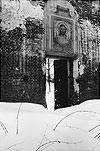|
|
The « Eastern Front » war has fascinated JS Cartier since childhood. The cataclysmic clash of Nazi and Communist ideologies in the former USSR, was the cause of violent death for some 20-million men, mostly Russian and German, not counting their allies and millions of civilian victims.
To carry out this historical project, Cartier benefitted from an invitation from the Russian press agency RIA Novosti, which made it possible for him to search for the traces of the conflict as well as its survivors.
Abstaining from visiting the more famous battlesites such as St.Petersburg and Volgograd (the former Leningrad and Stalingrad), Cartier chose instead to concentrate upon the Battle of Moscow, when the German Army suffered its first major defeat in the winter of 1941-42.
In March 2005, Cartier went on a first investigative trip (images herein) before embarking on the project proper, in June 2005.
|
|
| |
|

|
Novo-Petrovskoe
In 1941, Viktor KUZNETSOV’s grandmother Aleksandra KUZNETSOVA took an ax and began demolishing her home so that Russian tankers may use the lumber to build a bridge across the Maglusha river and attack the Germans. In 1965, tank general Katukov learned the story and ordered that the house be immediately rebuilt. For good measure, Fidel Castro sent a Cuban flag to honor Mrs KUZNETSOVA.
|
| |

|
Khimki
In November 1941, the Germans were stopped in this Moscow suburban town, only 8 miles from the Kremlin. Sign of the times, the monument representing an antitank barrier is surrounded today by malls and Western chain mega-stores. |
| |

|
Ivanovskoye
Klavdia CHATILINA, 84, chronicled village life under German occupation and is proud to show her medals. |
| |
 |
Volokolamsk
Evdokiya KISELOVA was 18 in November 1941 when she witnessed the hanging of a dozen young Komsomol partisans on the main square of this town, about 50 miles from Moscow. She poses where the gallows stood. |
| |
 |
Rzhev
Konstantin ARABCHIKOV, a former Red Army veteran poses at his home with a photo of himself as a young soldier, taken at the beginning of the war. |
| |
 |
Ivanovskoe
Ruins of a church destroyed during the battle of Moscow, in the Volokolamsk region. |
| |
 |
Zubcov
Tomb of a young Soviet tanker, who fell there in 1941. |
| |
 |
Volokolamsk Highway
At Km 114, a monument includes a Sturmgeschütz IIID, a German tank destroyer which blew up there on a mine. The imaginative stainless steel sculpture represents the explosion. |
| |
 |
Pogoreloe-Gorodisce
Elena ROZANELSKAYA was a young schoolteacher when the Germans invaded her village. Of 2000 inhabitants, only 800 survived. |
| |
 |
Khimki
In November 1941, the Germans were stopped in this Moscow suburban town, only 8 miles from the Kremlin. Sign of the times, this war memorial is overshadowed by Western chain mega-stores. |
| |
 |
Near Rzhev
Ruins of a former kholkoz dairy. |
| |
 |
Rzhev
Snow-covered wreaths honoring the 1943 victors. |
| |
 |
Rzhev
1943 patriotic inscription. «Young people and Komsomols, we shall rebuild Rzhev with our hands!» |
| |
 |
Lenino
A tank museum and soldiers’memorial with a burning eternal flame honors the defenders of Moscow, a few miles away. |
| |
 |
Istra
Close to Moscow, the destroyed magnificent New-Jerusalem Monastery has been lovingly restored, but still shows its wounds. |
| |

|
Knamenskoye
This palatial mansion was never rebuilt after the war. |
|